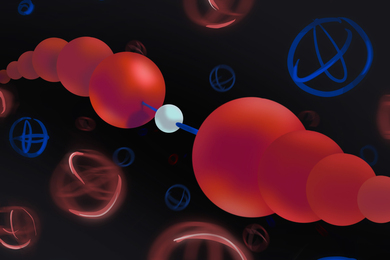In just seven years, the amount of waste recycled on the MIT campus has gone from less than 5 percent to 36 percent of the total waste generated.
Before the end of the year, the Environmental Programs Office hopes to bring that total to 40 percent, said Steven Lanou, program manager for Sustainability Initiatives. "It really is within reach," he said.
A number of on-campus programs are helping him reach that goal. In the spring, MIT participated in Recycle-Mania, a national contest among 40 universities to see which could collect the most recyclables in a two-month period. MIT placed in the top 10; Random and Westgate residence halls were the top finishers of MIT dorms.
In May 2004, the Working Group on Support Staff Issues' Recycling Committee held a "Clean Out Your Files Month." That month, the total amount of recycled office paper jumped from 33.3 tons to 39.5 tons. The event was held again in July; WGR is hoping for even better numbers. "If you can rip it, you can recycle it," says the WGR web site.
Clarity is an important component of raising the recycling rate, said Norman Magnuson, operations manager for Grounds Services in the Facilities Department. "One of our biggest problems before was contamination," said Magnuson. Now, receptacles are clearly marked for bottles, cans and paper. "We have been working to make recycling as easy as throwing something away," said Magnuson.
Though most people have become accustomed to putting bottles, cans and paper into recycling containers, Magnuson said that a majority of MIT's recycling comes from other areas. MIT composts food and recycles construction and demolition materials, rubber tires and yard waste.
Lanou and Justin Adams of the Environmental Health and Safety Office are working to spread the word about recycling before fall, when they expect the amount of waste to spike. For facilities this will mean additional recycling pickups and more recycling containers for students moving into residence halls. For Dining Services it will mean more cardboard boxes and increased compost.
This fall, in collaboration with the Environmental Programs Office, the Laboratory for Energy and the Environment will offer a Freshman Advising Seminar on campus greening, for credit. "We are hoping to build a community," said Adams.
The campus could still improve in some areas. For instance, many people on campus may not understand that discarded cardboard boxes may not be recycled unless they have been folded or broken down. Additionally, people often do not properly dispose of computers. Electronics and computer parts left in hallways may be thrown in the trash instead of recycled, unless the user calls Facilities to make arrangements, Magnuson explained.
Recycling is only part of the total effort. Reducing waste and using recycled products are also important components. "They really should all work together," said Adams, who is pleased by the improvements so far. In 2001, the campus produced 8,000 tons of trash (both recycled and non-recycled). In 2004, that number dropped to 7,000 tons.
Additionally, offices throughout MIT have begun using products purchased through Office Depot's green catalog, which offers recycled pens, paper, folders and more. "There has been an evolution of customers demanding greener materials," said Lanou. "It is an important effort to support."
Armed with the tools and information, MIT is rapidly becoming a greener campus, but there is still work left. "We are pretty new in this game," said Adams. "Much of the waste generated in the U.S. comes from institutions. We will keep improving and we will get where we want to be."






